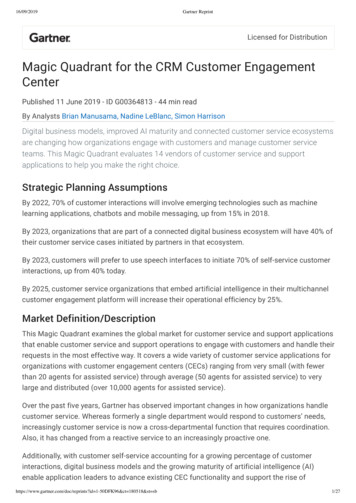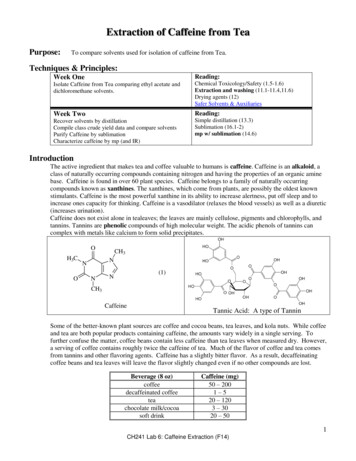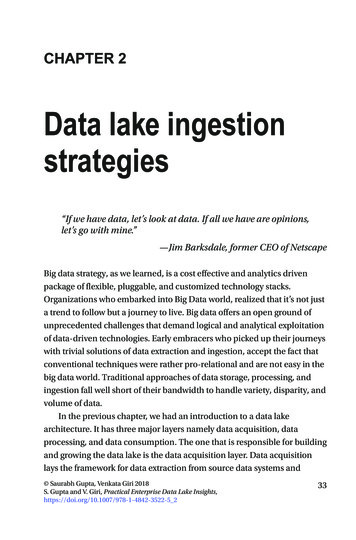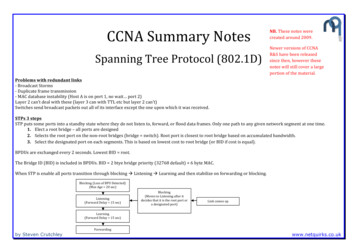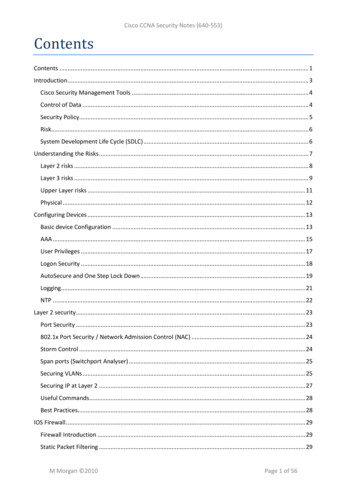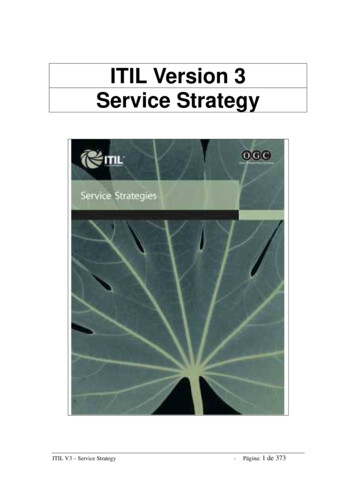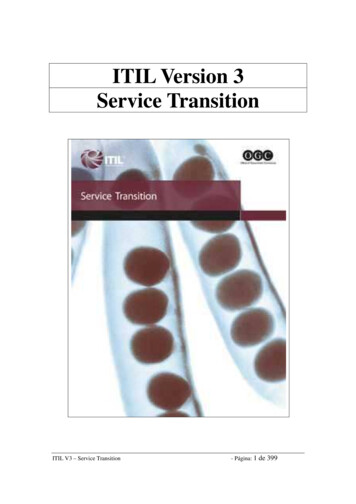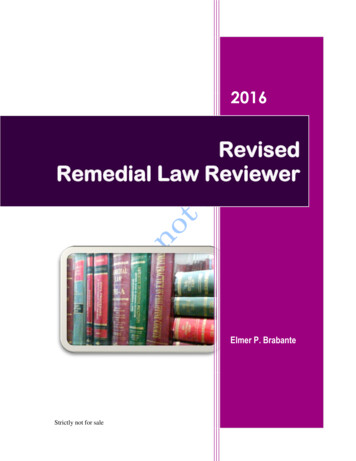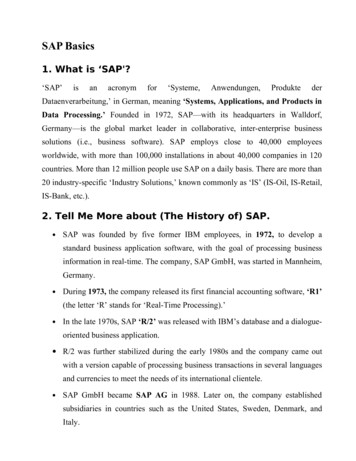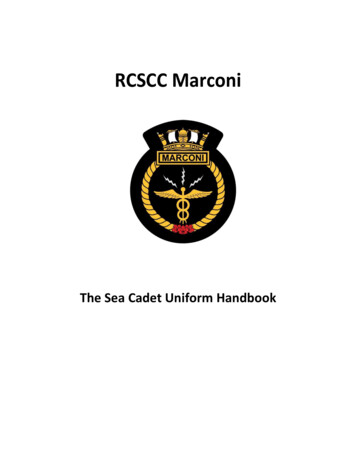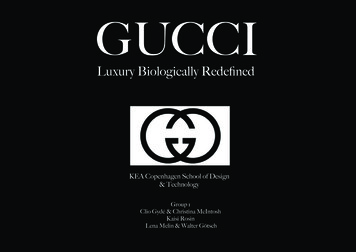
Transcription
GUCCILuxury Biologically RedefinedKEA Copenhagen School of Design& TechnologyGroup 1Clio Gydé & Christina McIntoshKaisi RosinLena Melin & Walter Götsch
EXECUTIVE SUMMARYFrom the stance of a development team, this report willpropose an alternative material for use within the fashionindustry. The focus will be on the luxury Italian fashionbrand Gucci who are searching for an innovative materialto create a Cradle to Cradle clothing line and accessorycollection to accompany their existing sustainable rangeof eyewear and footwear. Proposed within the report isthe research and eventual use of grown bacterial celluloseGucci garments.
EXECUTIVE SUMMARYiTABLE OF CONTENTSii1.0 INTRODUCTION12.0 GUCCI22.1 Company background22.2 Vision, Mission and Values22.3 S.W.O.T32.4 Ethnoraid33.0 PROPOSAL43.1 BioCouture53.2 Analysis63.3 Timeline74.0 CONCLUSION8REFERENCES9APPENDICES10
1.0 INTRODUCTIONThis report will aim to describe an alternative approach to the consumption and disposal ofclothing within the fashion industry with regards to the Cradle to Cradle theory. Grown bacterial cellulose fabric is proposed as a new material, and a solution to the problems associatedwith the production and disposal of textiles today.Gucci, the luxury Italian fashion brand, are used as a case study within the report where thecompany’s current position is analysed and potential future directions are proposed.-1-
2.0 GUCCI2.1 Company background2.2 Vision, Mission and ValuesThe House of Gucci, or simply Gucci, is an Italian fashion brand andleather goods label. It is part of the Gucci Group, which is owned byFrench company PPR. Gucci was founded by Guccio Gucci in Florencein 1921 and became one of the world’s leading luxury fashion brands during the Twentieth Century. The company has 376 directly operated storesand 8 249 employees (PPR, 2012). Since 2006 Frida Giannini has been thecreative director of Gucci (Gucci, 2012).The company s mission is to become the leader in luxury market at worldwide level.Gucci describe themselves as cool and responsible, and value themselves ontheir craftmanship. These three concepts are linked; Taking up responsibilitycan aswel be cool. For Gucci, Corporate Social Responsibility is an important part of their global strategy. They work with a holistic, yet realistic approach. They state that it is their duty to use their position as a luxury brandto pioneer and promote sustainability.The Gucci values are deeply embedded within ethics and in fact, the company began to work on a sustainability strategy in 2004. Quality remainsa main priority, but they began to elaborate upon this. Sustainability forpeople and the environment became part of the quality-concept. Gucci statethat their sustainability strategy is supported by their stakeholders.June 2010, saw the introduction of Gucci s 100% recyclable packaging.Shortly after this, the company launched a collection of environmentallyfriendly glasses which utilised biodegradable plastic and recycled metal;with a new collection of these to be launched in 2013. Biodegradable plasticis also to be used in a shoe collection which the company describe as a combination of style quality and new material (Ravagli, 2012).The Gucci target group is the affluent middle to upper classes. The consumeris hip, aged thirty plus, and above all, is an individual who invests in fashionas either a treat or a lifestyle (Ward, 2011).-2-
2.3 S.W.O.TStrengthsVery strong brand identityHigh level of control over distribution channelsStrong relationships with suppliers & retailersDirectly operated storesWeaknessesNot seen as being sustainableSeen as being tackyOpportunitiesEmerging luxury marketInnovative opportunities with textilesBe a pioneer of sustainability within the luxury marketThreatsLacking innovationCompetitors targeting the conscious consumer2.4 EthnoraidThe ethnoraid was carried out in Copenhagen at the Gucci store in orderto gain an insight into Gucci employees and customers. The main purposeof the interviews was to gather more information about the Gucci customer. It was important to know if the consumer was interested in sustainability.The average customer in Gucci is an upper class business person who prioritises quality and design. It is important that the products are luxuriousand exclusive. The customer does not consider the environmental issuesbut places emphasis on sustainability through the quality of merchandise.-3-
3.0 PROPOSALThere are many problems associated with the production of textiles and thedisposal of these. It is proposed, however, that grown bacterial cellulose fabric(see section 3.1) is a solution to these issues.The ultimate goal would be that the bacterial cellulose fabric becomes a viableproduct easily accessible to all. However at a research and development stage,the material is not yet commercially viable and there must be further investigation.In order to gather funds for the research is it proposed that a foundation isestablished. A capsule collection will promote the idea through the media e.g. atfashion week, Vogue magazine, blogs and Gucci museum. The capsule collection (see appendix 1.) will be available to consumers through select outlets witha limited and exclusive 1000 pieces. 15% of the profit of these will fund furtherresearch of the material.The following are proposed goals for Gucci to reach through the use of thematerial.To bring Cradle to Cradle products to the market.To make these available to consumers within 5 years.To introduce the idea to other companies.To create transparent documentation.To promote Gucci as an innovative brand.-4-
3.1 BioCouture‘With so many environmental concerns related to the production, consumption and disposal of fashion textiles BioCouture is pioneering a new ecofriendly and sustainable alternative.’ (BioCouture, 2012)BioCouture, still at a research and experimentation stage (TED, 2012), isan idea that very well has the potential to revolutionise the fashion industry,and become the future of fashion.The grown and biodegradable material, created by BioCouture founderand research fellow at Central Saint Martins, Suzanne Lee (Science Museum, 2012), gives a whole new meaning to the term disposable fashion.The bacterial cellulose fabric, cultivated in baths of green tea, is fully biodegradable at the end of its life and can be composted to return nutrientsback into a biological Cradle to Cradle cycle.The creation of the material sees a mother culture of yeast and the bacteriaAcetobacter feed on a sugary green tea solution. It is the biproduct of thisprocess however, that creates the fabric. As the bacteria feed, they spin acellulose thread that eventually fuse together to create a non woven mat.The mat can then be laid flat to dry and cut and sewn into garments. (Science Museum, 2012)-5-The main problem with the BioCouture material at this stage is that it isnot water resistant, and in fact, if it was to come in contact with rain for example, the garment would absorb the water, become incredibly heavy andthe seams would fall apart. (Luscombe, 2010) In order to make the productcommercially viable then, the material must become hydrophobic.One way in which this might be achieved is through a water resistantcoating. There are many options available, for instance the biodegradableOrganoTex a water-repellent finish for cellulose-based fabrics that usesno fluorocarbons or other chemicals that are toxic to the environment.The technology involves binding of a highly hydrophobic, biodegradablebio-additive to the fiber via strong covalent chemical bonds that are highlyresistant to laundering, according to OrganoClick. The finish can be applied using dipping, padding and other conventional application methods.The company adds that the water-repellency is durable and effective for thenormal life of the textile product (Textile World, 2011)
3.2 AnalysisThe grown bacterial cellulose material would be a solution to many environmental issues; using the Cradle to Cradle system, the renewable material does notproduce any waste, pollution or chemicals, and biodegrades at the end of its life. It can be produced with waste sugar water and it has proposed that it mightutilize factory waste. The fabric is very absorbent, therefore less dye is needed to achieve vibrant colours; one to eighteen. The material is of a similar qualityto leather, but requires substantially less resources and finance. The process involved in the creation of the material is relatively simple and has the potential tocreate many job opportunities.The project is very ambitious and innovative; it has the potential to have endless possibilities. It will educate the fashion consumer about sustainability and theCradle to Cradle philosophy but also has the opportunity to influence other industries, including the automotive, interior and medical industry, to think similarly and advance technological research. It has the potential to solve economic problems by starting new industries in new countries.The weaknesses of this project are that production requires a new system; very specific conditions and a lot of space which can make the costs initially high. Thematerial also requires further research which too might be costly. Created from bacteria, it is no surprise that to some, the fabric holds negative connotations;having been described by one critic as a ‘walking infection’. However, Gucci, with such a high luxury image and quality reputation, will promote the material asa desirable product using the name BioCouture. The company is also financially capable of funding the research required to bring the material to market.-6-
3.3 Timeline20 year timeline:1. Intensive research.2. Intensive research. Introducing the idea to the consumers.3. Capsule collection of 1000 pieces released.4. Research continues. Investigation of reactions.5. Second capsule collection of 3000 pieces.6. 3 other PPR companies start using the material.The material is a part of Gucci Ready to Wear Collection.7. 5 other PPR brands use the material.8. 5% of Gucci RTW in this material.9. Gucci starts collaboration with other brands.10. 10% of Gucci RTW Collection is in this material.Material available to many consumers.11. 20 other brands using this material.12. Continued collaborations with other brands.13. 20 RTW Collections use this material.14. Gucci profit increased by 10%.15. All PPR brands using this material.16. 20% of Gucci RTW is made of this material.17. 40 RTW Collections use this material.18. Gucci profit increased 15%.19. Continued collaboration with other companies.20. Easily accessible to consumers.-7-
4.0 CONCLUSIONThis project then, will lead Gucci further along the path it started out on in 2010. It is able to describe the possibility to innovate and become environmentally beneficial in an exclusive and pioneering way. Gucci s Cradle to Cradle products will no longer be limited to only glasses and shoes; thecollection will become complete with garments and accessories.The company will pioneer products that have the ability to change the textile market and change the Cradle to Grave fashion industry of today. Gucci will become renowned for their innovative take on the fashion product whilst remaining, as always; cool and responsible, and expert craftsmen.-8-
REFERENCESBIOCOUTURE, 2012. BioCouture. [online]. Available from: http://www.biocouture.co.uk [Accessed on: 6 July 2012].GUCCI, 2012. Creative Director. [online]. Available from: tive-director#2 [Accessed on:4 July 2012].LUSCOMBE, B, 2010. BioCouture. [online]. Available from: /0,28804,2029497 2030651 2029718,00.html [Accessed on: 7 July 2012].PPR, 2012. Gucci. [online]. Available from: http://www.ppr.com/en/brands/luxury/gucci [Accessed on: 4 July 2012].RAVAGLI, R., 2012. Gucci’s Sustainability Program, Fashion Summit, Copenhagen. [online]. Available from: /copenhagenfashionsummit.com/summit [Accessed on: 4 July 2012].SCIENCE MUSEUM, 2012. Trash Fashion. [online]. Available from: acket/ (Accessed on: 4 July 2012).TED, 2012. Suzanne Lee. [online]. Available from: http://fellows.ted.com/profiles/suzanne-lee [Accessed on: 7 July 2012].TEXTILE WORLD, 2011. OrganoClick Launches Biodegradable Water Repellent. [online]. Available from: anoClick Launches Biodegradable Water Repellent Binder.html [Accessed on: 9 July 2012].WARD, V. , 2011. Gucci PR plan. [online]. Available from: http://veronicaswriting.wordpress.com/?s gucci [Accessed on: 9 July 2012].-9-
APPENDICESAppendix 1. Capsule collection-10-
-11-
-12-
Gucci describe themselves as cool and responsible, and value themselves on their craftmanship. These three concepts are linked; Taking up responsibility can aswel be cool. For Gucci, Corporate Social Responsibility is an impor-tant part of their global strategy. They work with a holistic, yet realistic ap-proach. They state that it is their duty to use their position as a luxury brand
